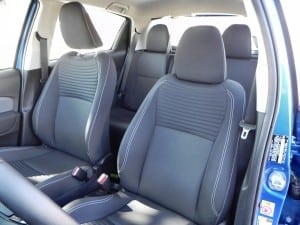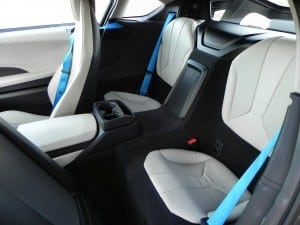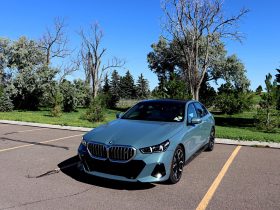In this special April 1st Showdown, we’re comparing two vehicles that may not seem in the same league on first glance, but which have far more in common than might be expected. Both have very small displacement engines, both are very lightweight, both are small cars, and both are very fuel efficient. They also both happen to be blue.
Fast VS Facts
| Contenders: | BMW i8 | Toyota Yaris |
| City/Hwy MPG: | Best city/hwy | Best city/hwy |
| Base Price: | $135,000ish | $14,845 |
| Strong Point: | 0-60mph in <4s | Cops specially trained to ignore this car. |
| Weakness: | No space for car seats | 0-60 mph.. eventually |
| Showdown Score: | 12 | 11 |
Daily Use Ergonomics
i8: 2 | Yaris: 4
 It may be surprising, but the major difference between these two vehicles is their relative design structure. Despite having so many similarities on paper, they are vastly different when seen in person. The BMW i8 is a supercar, with seating for two and enough room in the back for babies provided they are not legally required to have a child safety seat. The Yaris, on the other hand, is a four-door hatchback with back seats large enough for children and even small adults to sit in comfortably, with or without child safety seats. On top of that, the Yaris stands about two inches higher off the ground than does the BMW, giving it a clear advantage for those getting in and out of the vehicle. The door sill on the Toyota is about two inches high versus the seven-plus inch carbon fiber sill of the i8.
It may be surprising, but the major difference between these two vehicles is their relative design structure. Despite having so many similarities on paper, they are vastly different when seen in person. The BMW i8 is a supercar, with seating for two and enough room in the back for babies provided they are not legally required to have a child safety seat. The Yaris, on the other hand, is a four-door hatchback with back seats large enough for children and even small adults to sit in comfortably, with or without child safety seats. On top of that, the Yaris stands about two inches higher off the ground than does the BMW, giving it a clear advantage for those getting in and out of the vehicle. The door sill on the Toyota is about two inches high versus the seven-plus inch carbon fiber sill of the i8.
Family Friendliness
i8: 1 | Yaris: 3
As above, the Yaris wins hands down. With seating for four and even five (if clowns are involved) plus a cargo space behind, the Toyota is a far more family-friendly vehicle. The BMW i8, by comparison, seats two and a third if that person is limber and liberal about seatbelt use and has cargo space to carry a couple of toothbrushes, the car’s registration paperwork, and a flip-phone.
Ride Comfort
i8: 4 | Yaris: 3
 On this front, the BMW finally edges forward. Once you’re in the vehicle, the i8 is extremely comfortable and luxurious. Ride quality is very good, even for a hyper sports car like this. The Yaris, on the other hand, is an entry-level hatchback with a lot going for it, but it can in no way be described as “luxurious.” Compared to its contemporaries, it may have great ride quality, but compared to a luxury supercar like the i8, it’s a go-cart.
On this front, the BMW finally edges forward. Once you’re in the vehicle, the i8 is extremely comfortable and luxurious. Ride quality is very good, even for a hyper sports car like this. The Yaris, on the other hand, is an entry-level hatchback with a lot going for it, but it can in no way be described as “luxurious.” Compared to its contemporaries, it may have great ride quality, but compared to a luxury supercar like the i8, it’s a go-cart.
Powertrain Options
i8: 5 | Yaris: 1
Finally, the BMW trounces. Both vehicles have very small displacement engines. The BMW has a tiny three-cylinder gasoline engine supercharged for high output and coupled to an advanced electric drive system with all-wheel drive output. The Yaris has a little four-cylinder with.. uhh.. air conditioning. Zero to sixty times are more comparable if the BMW is allowed to try for 120 instead.
Final Assessments
The BMW i8 and the Toyota Yaris have many similarities on paper. Both have tiny engines. Both are capable of 40 miles to the gallon on the highway (or better) in practice. They both have blue paint. Yet they couldn’t be more different when compared in the real world. Confusing? Perhaps. But that’s how it is in automotive sometimes. Two vehicles that might seem to be basically the same thing can be completely different animals when compared side-by-side with measurable metrics. Sort of like blonds and redheads. But that’s for another day.
To read the individual reviews of the Showdown contenders, links are below for your convenience.







